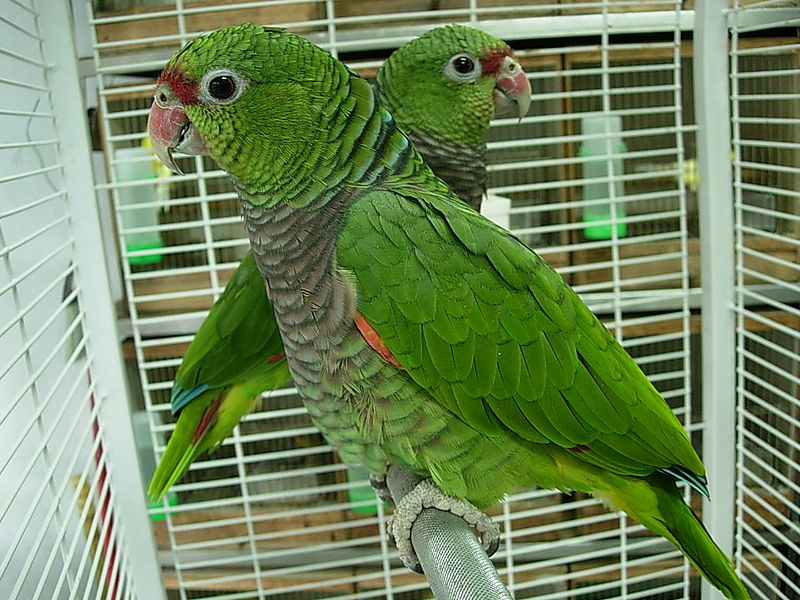Please see Part I of this article for general information and notes concerning other species.
Spectacled or White-Fronted Amazon Parrot, Amazona albifrons albifrons
Reaching only 11 inches in length and hailing from Mexico and Central America, this smallest of the Amazons is also the most affordable of the group. This may be in part to its somewhat undeserved reputation as a “screamer”. Its voice is loud and high-pitched, no doubt, and, like many of its relatives, the spectacled Amazon is quite vocal in general.
However, these vocal propensities render this red, white and blue-crowned parrot a very good mimic. Due to their relatively modest cost, spectacles were quite common in the trade when I first began working with birds, and I had the chance to work with quite a few. They seemed often to revel in their abilities…those I’ve been around have been most enthusiastic talkers, always ready to show off.
I heartily recommend spectacled Amazons to those with some parrot-keeping experience…properly socialized and handled, they make wonderful pets. They are not for those seeking a quiet parrot that will blend into the background, but are ideal for those who want a responsive, active household member about.
Yellow-Naped Amazon Parrot, Amazona (ochrocephala) auropalliata

Yellow-napes often take well to lots of physical contact with favored people…they may roll onto their backs and paw at you with their feet and engage in all sorts of similar games. Their size and sturdy build suits them well for controlled rough-housing, much more so than many parrots.
The yellow-nape is considered by some ornithologists to be a distinct species, while others classify it as a subspecies of the widely-ranging yellow-crowned parrot. Eight to nine additional yellow-crowned subspecies range from central Mexico to the Amazon Basin. The yellow-naped Amazon is found from southern Mexico to western Costa Rica. The various types have long been popular pets throughout their native ranges.
Vinaceous Amazon Parrot, Amazona vinacea
 The vinaceous Amazon differs from its relatives in general personality traits, being rather shy and retiring. Most have none of the “swagger” associated with its raucous cousins, and make gentle, affectionate pets. They fare best in quiet surroundings, and should be approached slowly, even when well-habituated to captivity.
The vinaceous Amazon differs from its relatives in general personality traits, being rather shy and retiring. Most have none of the “swagger” associated with its raucous cousins, and make gentle, affectionate pets. They fare best in quiet surroundings, and should be approached slowly, even when well-habituated to captivity.
This striking bird is distinct from most other Amazons in plumage as well. Its green feathers are rimmed in black and the forehead and chin are red. The throat and breast are infused with a beautiful purple-red cast, which sometimes extends to the abdomen, lending this parrot a quite unique appearance.
Unfortunately, vinaceous Amazons are quite rare in their native habitat, which is limited to southeastern Brazil and Paraguay, with remnant populations hanging on in Argentina. Deforestation is the main culprit in their disappearance from large tracts of former habitat. Like most parrots, they depend upon tree cavities in which to nest. Vinaceous Amazons seem even more demanding than most species as regards the size and location of nesting cavities, and hence are particularly sensitive to habitat loss. Field studies have shown that they compete poorly with other cavity nesting birds and mammals (i.e. various opossums), and that introduced honeybees commandeer favored tree holes with increasing frequency.
Given their precarious situation in the wild, vinaceous Amazons are an ideal choice for those with the space and expertise to attempt breeding.
Amazons have found use as “watchdogs”, and may have figured prominently in the Columbus’ journey the Americas. Please see my article at http://blogs.thatpetplace.com/thatavianblog/2008/05/14/did-parrots-help-columbus-find-his-way-to-america/ and the references cited there.
Yellow Naped Amazon image referenced from Wikipedia and originally posted by SEWilco under Wikipedia Commons
Vinaceous Amazon image referenced from Wikipedia and originally posted by TJLin under Wikipedia Commons.
 That Bird Blog – Bird Care and History for Pet Birds
That Bird Blog – Bird Care and History for Pet Birds


